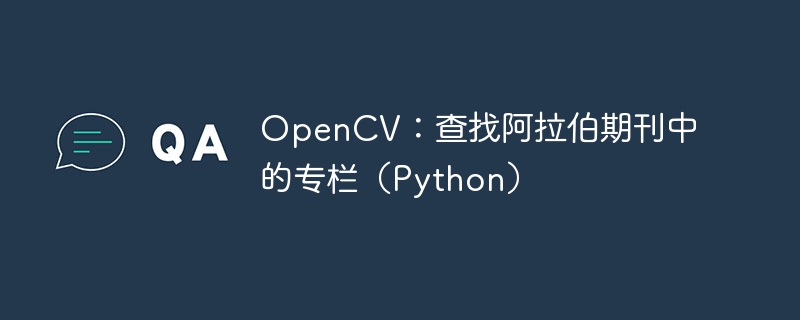OpenCV:尋找阿拉伯期刊中的專欄(Python)

我是 opencv 新手,也是 python 新手。我嘗試將在網路上找到的程式碼拼接在一起來解決我的研究問題。我有一本 1870 年的阿拉伯語日記,有數百頁,每頁都包含兩欄,並有粗黑邊框。我想將兩列提取為圖像文件,以便分別對它們運行 ocr,同時忽略頁眉和頁腳。下面是一個頁面範例:
第 3 頁
我有十頁原始列印作為單獨的 png 檔案。我編寫了以下腳本來處理每一個。它在 10 頁中的 2 頁中按預期工作,但無法在其他 8 頁中產生列。我對所有函數的理解不夠深入,無法知道我可以在哪裡使用這些值,或者我的整個方法是否被誤導了 -我認為最好的學習方法是詢問社區您將如何解決這個問題。
import cv2
def cutpage(fname, pnum):
image = cv2.imread(fname)
gray = cv2.cvtColor(image, cv2.COLOR_BGR2GRAY)
blur = cv2.GaussianBlur(gray, (7,7), 0)
thresh = cv2.threshold(blur, 0, 255, cv2.THRESH_BINARY_INV + cv2.THRESH_OTSU)[1]
kernel = cv2.getStructuringElement(cv2.MORPH_RECT, (3, 13))
dilate = cv2.dilate(thresh, kernel, iterations=1)
dilatename = "temp/dilate" + str(pnum) + ".png"
cv2.imwrite(dilatename, dilate)
cnts = cv2.findContours(dilate, cv2.RETR_TREE, cv2.CHAIN_APPROX_SIMPLE)
cnts = cnts[0] if len(cnts) == 2 else cnts[1]
cnts = sorted(cnts, key=lambda x: cv2.boundingRect(x)[0])
fullpage=1
column=1
for c in cnts:
x, y, w, h = cv2.boundingRect(c)
if h > 300 and w > 20:
if (h/w)<2.5:
print("Found full page: ", x, y, w, h)
filename = "temp/p" + str(pnum) + "-full" + str(fullpage) + ".png"
fullpage+=1
else:
print("Found column: ", x, y, w, h)
filename = "temp/p" + str(pnum) + "-col" + str(column) + ".png"
column+=1
roi = image[y:y+h, x:x+w]
cv2.imwrite(filename, roi)
return (column-1)
for nr in range(10):
filename = "p"+str(nr)+".png"
print("Checking page", nr)
diditwork = cutpage(filename, nr)
print("Found", diditwork, "columns")按照教程,我創建了一個模糊和擴張的二元反轉,以便它可以透過大的白色區域來識別不同的矩形區域。我還保存了每個擴展版本的副本,以便我可以看到它的樣子,這是處理後的上面的頁面:
第 3 頁已放大
“for c in cnts”循環應該會找到圖像中的大矩形區域。如果高寬比小於2.5,我會得到一個完整的頁面(沒有頁眉和頁腳,這效果很好),如果高寬比大於這個,我知道它是一個列,並且它保存了這個例如temp/ p2-col2.png
我得到了一些漂亮的完整頁面,沒有頁眉和頁腳,也就是說,只有較大的黑色邊框,但沒有被切成列。在 10 頁中的 2 頁中,我得到了我想要的內容,即:
第 2 頁的成功欄位
由於我有時會得到所需的結果,因此一定有某些東西正在起作用,但我不知道如何進一步改進它。
編輯:
以下是更多頁面範例:
p0
p1
p5
正確答案
我嘗試了一些沒有任何擴張的東西,因為我想看看是否可以只使用中間線作為“分隔符號” 。這是程式碼:
im = cv2.cvtcolor(cv2.imread("arabic.png"), cv2.color_bgr2rgb) # read im as rgb for better plots
gray = cv2.cvtcolor(im, cv2.color_rgb2gray) # convert to gray
_, threshold = cv2.threshold(gray, 250, 255, cv2.thresh_binary_inv) # inverse thresholding
contours, _ = cv2.findcontours(threshold, cv2.retr_external, cv2.chain_approx_none) # find contours
sortedcontours = sorted(contours, key = cv2.contourarea, reverse=true) # sort according to area, descending
bigbox = sortedcontours[0] # get the contour of the big box
middleline = sortedcontours[1] # get the contour of the vertical line
xmiddleline, _, _, _ = cv2.boundingrect(middleline) # get x coordinate of middleline
leftboxcontour = np.array([point for point in bigbox if point[0, 0] < xmiddleline]) # assign left of line as points from the big contour
rightboxcontour = np.array([point for point in bigbox if point[0, 0] >= xmiddleline]) # assigh right of line as points from the big contour
leftboxx, leftboxy, leftboxw, leftboxh = cv2.boundingrect(leftboxcontour) # get properties of box on left
rightboxx, rightboxy, rightboxw, rightboxh = cv2.boundingrect(rightboxcontour) # get properties of box on right
leftboxcrop = im[leftboxy:leftboxy + leftboxh, leftboxx:leftboxx + leftboxw] # crop left
rightboxcrop = im[rightboxy:rightboxy + rightboxh, rightboxx:rightboxx + rightboxw] # crop right
# maybe do you assertations about aspect ratio??
cv2.imwrite("right.png", rightboxcrop) # save image
cv2.imwrite("left.png", leftboxcrop) # save image我沒有使用任何有關寬高比的斷言,所以也許這仍然是您需要做的事情..
基本上,這種方法中最重要的線條是基於 x 座標產生左輪廓和右輪廓。這是我得到的最終結果:
邊緣仍然有一些黑色部分,但對於 ocr 來說這應該不是問題。
僅供參考:我在 jupyter 中使用以下軟體包:
import cv2 import numpy as np %matplotlib notebook import matplotlib.pyplot as plt
v2.0:僅使用大框偵測來實現:
所以我做了一些擴張,這個大盒子很容易被偵測到。我使用水平內核來確保大盒子的垂直線始終足夠粗以被檢測到。然而,我無法解決中間線的問題,因為它非常細......儘管如此,這裡是上述方法的程式碼:
im = cv2.cvtcolor(cv2.imread("1.png"), cv2.color_bgr2rgb) # read im as rgb for better plots
gray = cv2.cvtcolor(im, cv2.color_rgb2gray) # convert to gray
gray[gray<255] = 0 # added some contrast to make it either completly black or white
_, threshold = cv2.threshold(gray, 250, 255, cv2.thresh_binary_inv) # inverse thresholding
thresholddilated = cv2.dilate(threshold, np.ones((1,10)), iterations = 1) # dilate horizontally
contours, _ = cv2.findcontours(thresholddilated, cv2.retr_external, cv2.chain_approx_none) # find contours
sortedcontours = sorted(contours, key = cv2.contourarea, reverse=true) # sort according to area, descending
x, y, w, h = cv2.boundingrect(sortedcontours[0]) # get the bounding rect properties of the contour
left = im[y:y+h, x:x+int(w/2)+10].copy() # generate left, i included 10 pix from the right just in case
right = im[y:y+h, int(w/2)-10:w].copy() # and right, i included 10 pix from the left just in case
fig, ax = plt.subplots(nrows = 2, ncols = 3) # plotting...
ax[0,0].axis("off")
ax[0,1].imshow(im)
ax[0,1].axis("off")
ax[0,2].axis("off")
ax[1,0].imshow(left)
ax[1,0].axis("off")
ax[1,1].axis("off")
ax[1,2].imshow(right)
ax[1,2].axis("off")這些是結果,您可以注意到它並不完美,但同樣,由於您的目標是 ocr,這應該不是問題。
請告訴我這是否可以,如果不行,我會絞盡腦汁尋找更好的解決方案...
v3.0:一種獲得更直影像的更好方法,這將提高 ocr 的品質。
受到我在這裡的另一個答案的啟發:answer。拉直圖像是有意義的,這樣 ocr 就有更好的結果。因此,我在檢測到的外框上使用了四點變換。這將使圖像稍微變直,並使文字更加水平。這是程式碼:
im = cv2.cvtcolor(cv2.imread("2.png"), cv2.color_bgr2rgb) # read im as rgb for better plots
gray = cv2.cvtcolor(im, cv2.color_rgb2gray) # convert to gray
gray[gray<255] = 0 # added some contrast to make it either completly black or white
_, threshold = cv2.threshold(gray, 250, 255, cv2.thresh_binary_inv) # inverse thresholding
thresholddilated = cv2.dilate(threshold, np.ones((1,10)), iterations = 1) # dilate horizontally
contours, _ = cv2.findcontours(thresholddilated, cv2.retr_external, cv2.chain_approx_none) # find contours
largest_contour = max(contours, key = cv2.contourarea) # get largest contour
hull = cv2.convexhull(largest_contour) # get the hull
epsilon = 0.02 * cv2.arclength(largest_contour, true) # epsilon
pts1 = np.float32(cv2.approxpolydp(hull, epsilon, true).reshape(-1, 2)) # get the points
result = four_point_transform(im, pts1) # using imutils
height, width = result.shape[:2] # get the dimensions of the transformed image
left = result[:, 0:int(width/2)].copy() # from the beginning to half the width
right = result[:, int(width/2): width].copy() # from half the width till the end
fig, ax = plt.subplots(nrows = 2, ncols = 3) # plotting...
ax[0,0].axis("off")
ax[0,1].imshow(result)
ax[0,1].axvline(width/2)
ax[0,1].axis("off")
ax[0,2].axis("off")
ax[1,0].imshow(left)
ax[1,0].axis("off")
ax[1,1].axis("off")
ax[1,2].imshow(right)
ax[1,2].axis("off")具有以下軟體包:
import cv2 import numpy as np %matplotlib notebook import matplotlib.pyplot as plt from imutils.perspective import four_point_transform
正如您從程式碼中看到的,這是一種更好的方法,由於四點變換,您可以強制圖像居中且水平。此外,不需要包含一些重疊,因為影像分離得很好。這是一個供您參考的範例:
以上是OpenCV:尋找阿拉伯期刊中的專欄(Python)的詳細內容。更多資訊請關注PHP中文網其他相關文章!

熱AI工具

Undresser.AI Undress
人工智慧驅動的應用程序,用於創建逼真的裸體照片

AI Clothes Remover
用於從照片中去除衣服的線上人工智慧工具。

Undress AI Tool
免費脫衣圖片

Clothoff.io
AI脫衣器

Video Face Swap
使用我們完全免費的人工智慧換臉工具,輕鬆在任何影片中換臉!

熱門文章

熱工具

記事本++7.3.1
好用且免費的程式碼編輯器

SublimeText3漢化版
中文版,非常好用

禪工作室 13.0.1
強大的PHP整合開發環境

Dreamweaver CS6
視覺化網頁開發工具

SublimeText3 Mac版
神級程式碼編輯軟體(SublimeText3)
 H5頁面製作是前端開發嗎
Apr 05, 2025 pm 11:42 PM
H5頁面製作是前端開發嗎
Apr 05, 2025 pm 11:42 PM
是的,H5頁面製作是前端開發的重要實現方式,涉及HTML、CSS和JavaScript等核心技術。開發者通過巧妙結合這些技術,例如使用<canvas>標籤繪製圖形或使用JavaScript控制交互行為,構建出動態且功能強大的H5頁面。
 為什麼inline-block元素會出現錯位現象?如何解決這個問題?
Apr 04, 2025 pm 10:39 PM
為什麼inline-block元素會出現錯位現象?如何解決這個問題?
Apr 04, 2025 pm 10:39 PM
關於inline-block元素錯位顯示的原因及解決方案在編寫網頁佈局時,我們常常會遇到一些看似奇怪的顯示問題。比...
 如何通過CSS自定義resize符號並使其與背景色統一?
Apr 05, 2025 pm 02:30 PM
如何通過CSS自定義resize符號並使其與背景色統一?
Apr 05, 2025 pm 02:30 PM
CSS自定義resize符號的方法與背景色統一在日常開發中,我們經常會遇到需要自定義用戶界面細節的情況,比如調...
 如何使用CSS的clip-path屬性實現分段器的45度曲線效果?
Apr 04, 2025 pm 11:45 PM
如何使用CSS的clip-path屬性實現分段器的45度曲線效果?
Apr 04, 2025 pm 11:45 PM
如何實現分段器的45度曲線效果?在實現分段器的過程中,如何讓點擊左側按鈕時右側邊框變成45度曲線,而點�...
 2018-2024年比特幣最新價格美元大全
Feb 15, 2025 pm 07:12 PM
2018-2024年比特幣最新價格美元大全
Feb 15, 2025 pm 07:12 PM
實時比特幣美元價格 影響比特幣價格的因素 預測比特幣未來價格的指標 以下是 2018-2024 年比特幣價格的一些關鍵信息:
 如何通過JavaScript或CSS控制瀏覽器打印設置中的頁首和頁尾?
Apr 05, 2025 pm 10:39 PM
如何通過JavaScript或CSS控制瀏覽器打印設置中的頁首和頁尾?
Apr 05, 2025 pm 10:39 PM
如何使用JavaScript或CSS控制瀏覽器打印設置中的頁首和頁尾在瀏覽器的打印設置中,有一個選項可以控制是否顯�...








